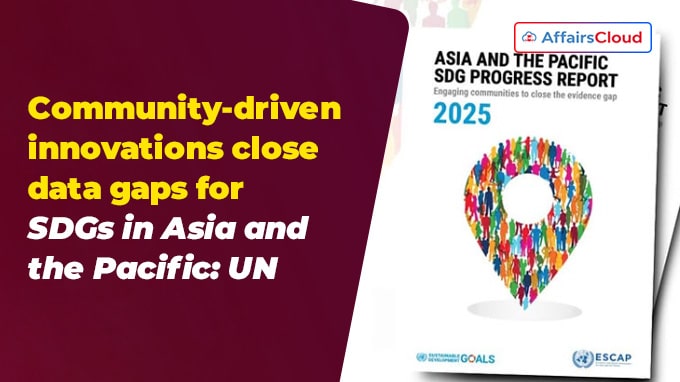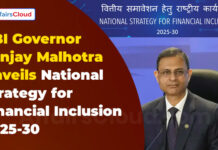 In February 2025, the United Nations Economic and Social Commission for Asia and the Pacific (UNESCAP) published the report titled “Asia and the Pacific SDG Progress Report: Engaging Communities to Close the Evidence Gap 2025”, which provides a comprehensive assessment of progress on the 17 Sustainable Development Goals (SDGs) and their 169 targets in the Asia-Pacific region.
In February 2025, the United Nations Economic and Social Commission for Asia and the Pacific (UNESCAP) published the report titled “Asia and the Pacific SDG Progress Report: Engaging Communities to Close the Evidence Gap 2025”, which provides a comprehensive assessment of progress on the 17 Sustainable Development Goals (SDGs) and their 169 targets in the Asia-Pacific region.
- The report highlights to engage communities to close the evidence gap, emphasizing the importance of accurate data collection to support decision-making.
- The Asia-Pacific SDG Progress Report 2025 stresses that urgent action is still needed in order to achieve the 17 SDGs by 2030 Agenda.
Note: On 22 September 2024, global leaders adopted the Pact for the Future at the Summit of the Future, reaffirming their commitment to achieving the 2030 Agenda for Sustainable Development.
Highlights of the Report:
i.The report highlights significant progress in the Asia-Pacific region on SDGs, including reducing income poverty (SDG 1), addressing undernourishment (SDG 2), supporting small-scale industries (SDG 9), reducing hazardous waste (SDG 12), mitigating land degradation (SDG 15), and combating human trafficking and intentional homicide (SDG 16).
- Additionally, the availability of SDG data has increased to 54%.
ii.However, overall progress on SDGs in the region is largely off track, with many targets advancing too slowly or stagnating.
iii.SDG 13 (climate action) shows signs of regression, and critical data gaps remain in areas like gender equality (SDG 5) and peace, justice, and strong institutions (SDG 16).
Key Findings of the Report:
i.Overall Progress: The Asia-Pacific region is significantly off track in achieving the 2030 Agenda for Sustainable Development.
- Out of 169 SDG targets, only 16 are on track, 83 require acceleration, and 18 show a negative trend.
- Climate change (Goal 13), inequality (Goal 10), and unsustainable consumption (Goal 12) are major challenges hindering progress.
ii.Areas of Progress: In Industry, Innovation, and Infrastructure (Goal 9), there has been an expansion in mobile network coverage and technological advancements.
- Good Health and Well-being (Goal 3): Reduction in maternal and infant mortality rates.
- No Poverty (Goal 1): Decline in income poverty rates.
- Zero Hunger (Goal 2): Improvement in food security and nutrition levels.
iii.Areas of Concern and Regression: Climate Action (Goal 13) remains a major challenge, as the Asia-Pacific region contributes 50% of global greenhouse gas (GHG) emissions, making it the largest polluter.
- Quality Education (Goal 4): Poor reading and mathematical proficiency among students.
- Decent Work and Economic Growth (Goal 8): Rising occupational injuries, economic inequality, and youth unemployment.
- Life Below Water (Goal 14) & Life on Land (Goal 15): Biodiversity loss and environmental degradation.
- Responsible Consumption and Production (Goal 12): Increase in fossil fuel subsidies and unsustainable production.
iv.Data and Statistical Gaps: Data is insufficient for 52 SDG targets, especially in areas like gender equality (Goal 5) and peace, justice, and strong institutions (Goal 16).
- Countries in Special Situations (CSS) are Least Developed Countries (LDCs), Landlocked Developing Countries (LLDCs), and Small Island Developing States (SIDS) face unique challenges and require targeted policies.
v.Country-wise and Subregional Performance:Compared to global averages, the Asia-Pacific region performs well in reducing income poverty (Goal 1), improving food security (Goal 2), and enhancing industry and infrastructure (Goal 9).
- However, the region lags behind in decent work (Goal 8), climate action (Goal 13), and marine conservation (Goal 14).
- Diverse progress across subregions shows that some countries are excelling while others are regressing, requiring specific policy interventions.
Major Challenges Hindering SDG Implementation:
i.Limited financial resources for statistical modernization.
ii.Rising inequality, climate disasters, and economic uncertainties.
iii.Lack of a whole-of-society approach in SDG implementation.
Way Forward: Policy Recommendations:
i.Strengthening Data Collection: Governments must invest in digital statistical systems to address data gaps.
ii.Enhancing Community Engagement: Involving Civil Society Organizations (CSOs) can improve policy formulation and implementation.
iii.Boosting Regional Cooperation: Asia-Pacific nations must collaborate to address climate change, inequality, and resource mobilization.
About United Nations Economic and Social Commission for Asia and the Pacific (UNESCAP):
The UNESCAP was originally established as the United Nations(UN) Economic Commission for Asia and the Far East (ECAFE) on March 28, 1947 and was renamed as ESCAP on August 1, 1974.
Executive Secretary– Armida Salsiah Alisjahbana (Indonesia)
Headquarters– Bangkok, Thailand
Established– 1947




